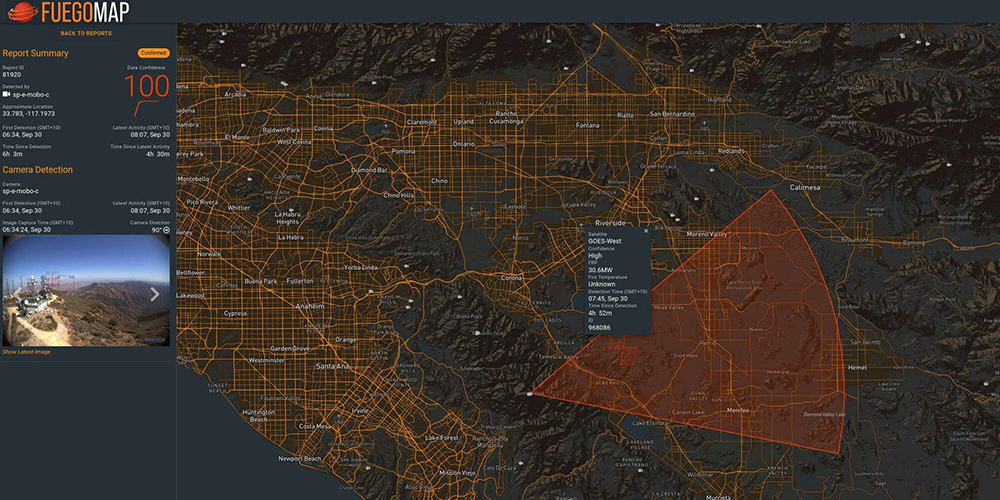Fireball International is planning to launch a prototype satellite in 2022 to demonstrate its bushfire detection software and improved image capture and refresh time. This Queensland-based company is hoping to be able to map the whole of Australia within 5 minutes, improving fire detection response times.
Fireball International is currently working with a number of US agencies to deliver rapid bushfire notifications utilising software originally designed for measuring the expansion rate of the Universe by looking for explosions in supernovae. The bushfire detecting software currently uses the images from a number of Earth Observing (EO) Weather satellites including LandSAT (US), INSAT, Sentinel (ESA) and Himawari-8 (Japan) as well as ground-based cameras to deliver real time fire detection alerts.
This month Fireball International has announced its plans to expand its capabilities and is developing an Australian built, launched and delivered demonstrator satellite. This satellite is designed to prove Fireball International’s end-to-end fire detection process and will lead to a specialist imaging package being added to a number of future Geostationary Earth Orbit (GEO) satellites to provide global coverage. It is this proof of concept that they hope will lead to the provision of end-to-end fire detection services.
Fireball International started in 2018 and has gone from an idea to a business with big plans. Based on the Sunshine coast, this month Fireball International announced a deal with Space Machines and Gilmour Space to launch this demonstrator satellite into orbit next year. The satellite will use a tug from Space Machines to deliver it into its final orbit, having been delivered on the Gilmour Space Eris rocket.
Adelaide-based Space Machines, last year signed up to be the first customer for Gilmour Spaces’ Eris Rocket, expected to be Australia’s first large-payload lifting launch vehicle heading to orbit next year. The startup is focussing on developing in space transportation system to cost effectively place satellites into low Earth orbit (LEO), GEO and Cis-Lunar Orbits.
Associate Professor Tim Ball, Fireball International’s CTO said that the new satellite is “a technology demonstrator, that is going to demonstrate that the same wavelengths that are useful for finding fire can also be used for characterising vegetation and fuel moisture.”
HOW DOES IT WORK?
What makes the company’s plans so unique is that it is bringing together a number of different technologies to provide a comprehensive fire risk picture to the relevant authorities. Currently, Fireball International uses a mix of on-the-ground cameras and satellite images from a variety of EO satellites to spot potential fires, looking for tell-tale signatures of smoke particles. These ground-based cameras are in high risk locations and in high places, such as mountain tops. The software is designed to analyse and compare pictures using machine learning, sending out alerts when a potential fire is spotted.
We will be able to “detect a fire the size of a lorry” said Ball.
In the future, with Fireball International’s shortwave infrared sensors on board a number of EO Geostationary Satellites, it is hoped that they will not only be able to provide early detection of smaller and more remote bush fires but also provide information on high risk areas for potential fires due to high bush fuel load.
Currently Australia relies heavily on international EO satellites for imaging, whereas Fireball International is looking towards having a hosted payload on a number GEO communication satellites, should the demonstrator satellite prove their capabilities.
One of the challenges of bushfire detection is that it requires large amounts of data and then the processing power to assess every image. Fireballs International’s onboard processing and information delivery systems according to Ball will make it “really simple, make it download really fast and be available to every firefighter on the ground”.
THE TECHNOLOGY
“We look at groups of pixels at once and understand the background level and then we see one pixel stick out above the rest which will be the fire” said Ball.
Medium Wave infrared images are the key to bushfire detection; this added to modern technology and machine learning software is allowing companies like Fireball International to see changes in the Earth much better than before. Fireball International is hoping that in the future it will be able to map the whole of Australia within 5 minutes, with a 160m ground sample.
Christopher Tylor, Fireball International’s Managing Director, said that they use a system of a system and is modular so that “when demand is there we can ramp up higher and higher. We use a series of machine learning algorithms to check each other.” The current system being used in California which has over 1000 cameras, can detect 99% of bushfires within 5 minutes. Fireball International is hoping to have 600 cameras in high risk areas of Australia by the end of 2021 to support their satellite imaging.
Behind the satellites, the cameras and the images are complex machine learning algorithms. These algorithms were developed by Dr Carl Pennypacker at University of California, Berkeley and make up the Fire Urgency Estimator in Geosynchronous Orbit, Early detection of wildfires from space or FUEGO system. This system, which stemmed from a system designed to look at the expansion rate of the universe, where it is necessary to find a small signal in a lot of noise, has been licenced to Fireball International.
THE COST OF BUSHFIRES
With over 50 years of fighting experience behind him, Ball understands first hand why it is important to get to the fire quickly. A 2020 report into the economic cost of bushfires from Australian National University (ANU) and funded by Fireball International, suggested that not only are bushfires in Australia likely to become more frequent they will also “more likely, last longer and [be] more intense.”
It also suggested that a “key determinant of whether a fire ignition turns into a large and costly fire is the size of the fire when fire suppression arrives.” So the quicker it is detected the smaller it will be when the emergency services arrive, giving a higher chance of being extinguished before significant impact.
The impact from bushfires is not just on the ground. A recent report suggested that the 2019/20 Australian fire season propelled a record breaking amount of pollutants into the stratosphere. With five fires in 2020 being over 1MHa it is not surprising. There have only been 29 fires of that size since 1850. When we add the total economic cost of bushfires in Australia, which runs into billions to the impacts for both our biodiversity and our climate, it is important to detect, notify and extinguish bushfires as quickly as possible.
READ ORIGINAL ARTICLE written by Ruth Harrison, 21-Mar-2021




